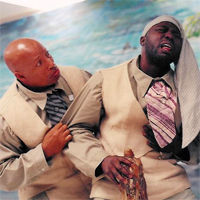"Shakespeare Behind Bars" - documentary
Rogerson’s Look Inside the Hearts and Minds of Unusual Shakespearian Scholars
Published Nov 22, 2005
[an error occurred while processing this directive]
Edit page New page Hide edit links
“When is a man forgiven?” Towards the end of director Hank Rogerson’s moving documentary study “Shakespeare Behind Bars,” an inmate at Luther Luckett Correctional Complex in Kentucky asks this seemingly innocuous question. Yet for Rogerson’s film, these words encompass the very heart of the film; they force viewers to consider extreme states of our human existence and to reconcile how both society and man struggle to embrace felony and felicity, reproach and redemption, vice and virtue, punishment and pardon.
Rogerson’s feature documentary opens with a compelling establishing shot. The camera clearly focuses on a group of three men and their intense study: Sammie practices lines from Shakespeare’s The Tempest, while one of his coaches eventually questions, “How big can you dream?” Inspiration and hope pour from the dialogue, yet the entire time the viewer can’t help but notice their unusual stage and costumes too: a plot of green grass surrounded by steel and standard issue brown uniforms. Rogerson’s camera work captures his subjects with such subtlety that you forget the jarring social context: the scales of justice have confined these men to a life behind bars. As the actors depart from their rehearsal outside and reenter the walls of the prison, Rogerson takes viewers inside the convicts’ world to present a candid view of how society’s forgotten have found solace in the bard’s beautiful plays.
Through a chronologically structured narrative, Rogerson’s film follows the men on their annual journey returning from summer “break,” choosing roles, practicing lines, rehearsing scenes, and eventually performing their play. To artfully build the story, editor Victor Livingston seamlessly weaves scenes depicting the troupe’s growing understandings of its lines and characters with interview segments where individual inmates reveal their painful personal histories. This structure supports the men's growing realizations that while trying to come to terms with their characters, in reality the men are truly trying to come to terms with their own inner demons as well.
Yet, the more startling discovery is that ironically the personal histories of each inmate eerily mirror the actual background of the characters that each man is trying to portray. In one instance, the inmate “Red,” a bisexual born of a single mother, describes how he learned of his paternity at age 15. Red plays the character Miranda, who at age 15 also inquires into her parentage having been brought up by just a father. Red talks about his difficulties trying to fill a woman’s shoes and his realization that his work understanding Miranda has forced him to come to terms with his own father’s role in his life.
To further layer this complex retelling, James Wesley Stemple’s haunting music seeks to transition between shots and helps to drive the narrative forward. His lamenting string accompaniments provide a lyrical arch to allow the audience time to process those painful personal memories that the inmates reveal. His wonderfully original score acts as another character to build Rogerson’s “tempest.”
While Rogerson relies on the natural story arch to frame and pace his film, the documentary’s one fault lies in the fact that it tends to falter when he introduces the conflicts between the convicts. In these scenes, the personality conflicts that threaten to destroy the production seem like mere tempests in teapots when juxtaposed against the stark, individual personal tragedies. But ultimately, the film arrives at a satisfying resolution.
In the end, Rogerson’s film reaches a paradoxical yet profound conclusion. He is able to offer the audience hope, but he never allows us to forget the prisoners’ dispair. He is able to entertain, to make us laugh and cry, yet he forces us to think about a world where forgiveness doesn’t arrive on a gentle breeze, rather it’s destructive path is the tempest that threatens to destroy the very soul in the process.
[In Technology]
Additional Events at ProFusion 2011, DV Expo East, and Columbia College Chicago May 26, 2011
[In Resources]
Fest to fete special guests Vera Farmiga, Paul Haggis; Mike O’Malley joins Anne Meara as hosts of Late Night Storytelling May 26, 2011




Add a Comment
Please be civil.